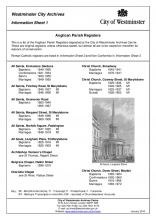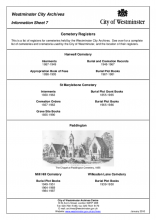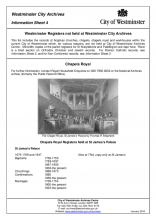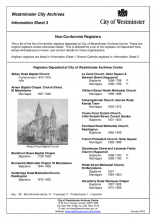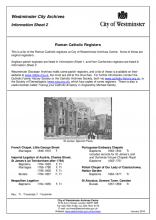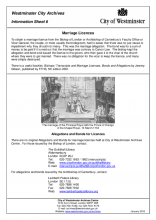Parish registers
For baptism, marriage and burial records from before the introduction of Civil Registration in 1837, you will need to consult parish registers.
Church of England (Anglican) parish registers from 1539 to the 20th Century are available for the old City of Westminster as well as copies of most registers for St Marylebone and Paddington (the London Metropolitan Archives hold the originals).
Our Anglican registers information sheet lists our parish records collection. Our church and cemetery records include information on our holdings of vestry minutes and more.
The Registers not held at the Archives information sheet lists Anglican registers not held by the Archives Centre, or, where they are held, with a short section of Orthodox and Jewish records. This list is not exhaustive - there may be other registers that we do not yet know of.
See our information sheets below for a list of non-conformist and Roman Catholic registers not held here.
Requesting copies of parish registers
We can supply copies of Westminster parish register entries.
To order a copy, you need to provide the exact date and the church in which the event was registered.
We can also provide census entries where the exact address is known. To request a copy, please contact us by post or by email. A charge of £5 is made per copy supplied.
Baptism registers
Baptism registers usually give the parents' names and sometimes the child's date of birth. From 1813 onwards they give the child's name, parents' names, address, father's occupation, officiating minister and sometimes the date of birth of the child.
Baptism registers don't give the mother's maiden name, unless the child was illegitimate.
Marriage registers
Marriage registers give the couple's name and their parish of residence. The father's name is given if the bride or groom is underage.
From 1754 onwards they give names, parish, marital condition, whether married by licence or banns, name of officiating minister, signatures and witnesses.
From 1837 onwards they give names, ages (often just "full age" which means 21 or over), marital condition, occupation, address, fathers' names and occupations, names of officiating minister, signatures and witnesses.
Banns registers
Banns registers have no additional information to marriage registers. They only record the parishes of the couple and the date of the calling of the banns.
They are useful in tracing a marriage which might have taken place in another parish.
Marriage licences
A description of our holdings and location of London marriage allegations can be in found on the marriage licences information sheet.
The marriage allegations of the Vicar-General, 1694 to 1850, and Faculty Office of the Archbishop of Canterbury, 1701 to 1850, are available for a fee on London Origins.
Fleet marriages
Before Lord Hardwicke's Marriage Act of 1754, marriages did not legally have to take place in church.
In the late-17th century, about half of all marriages in London were clandestine with no banns or licences. One of the most famous centres for clandestine marriages was the Fleet Prison.
Fleet marriages took place in the area just around the Fleet prison by clergymen debtors, and all types of people were married here.
A Friend of Westminster Archives has compiled an index of Fleet marriages mentioned within the St Martin-in-the-Fields settlement examinations for 1709 to 1712.
The index is available for consultation in Westminster Archives Centre. The surviving Fleet registers are held at the National Archives.
Burial registers
Burial registers give the name and usually whether the person was a man, woman or child (M, W or C). They sometimes give the age, occupation, address or next of kin. From 1813 onwards they give the name, address, date of burial, age and officiating minister.
It is also sensible to check whether any burial fee books have survived which can provide further information on your ancestor, such as the cause of death.
After 1853 burials were not carried out in central London but in cemeteries in the Suburbs.
International Genealogical Index
The marriage and baptism registers of some churches have been indexed by the Church of Jesus Christ of Latter Day Saints in the International Genealogical Index (IGI).
This is a name index to baptisms and marriages from 1538 to circa 1885. Burials are not indexed and it is not a comprehensive index but it is a good place to start searching.
The 1988 and 1992 editions of the IGI for London and Middlesex are available on microfiche at the Archives Centre. The index is also available on the internet via FamilySearch.
Pallot's Marriage Index
Pallot's Index to Marriages is available free of charge on CD in the searchroom. The index covers more than 1.5 million marriage registrations, mainly from London and Middlesex, from 1780 to 1837.
It also includes entries from 2,500 parishes in 38 counties outside of London, many of which are not available in other sources.
The original paper slips of the Pallot's Index are owned and held at the Institute of Heraldic and Genealogical Studies.
Pallot's Marriage Index is also available for a fee on Ancestry. Ancestry is available for free in the search room at the Archives Centre and at all the Westminster libraries.

